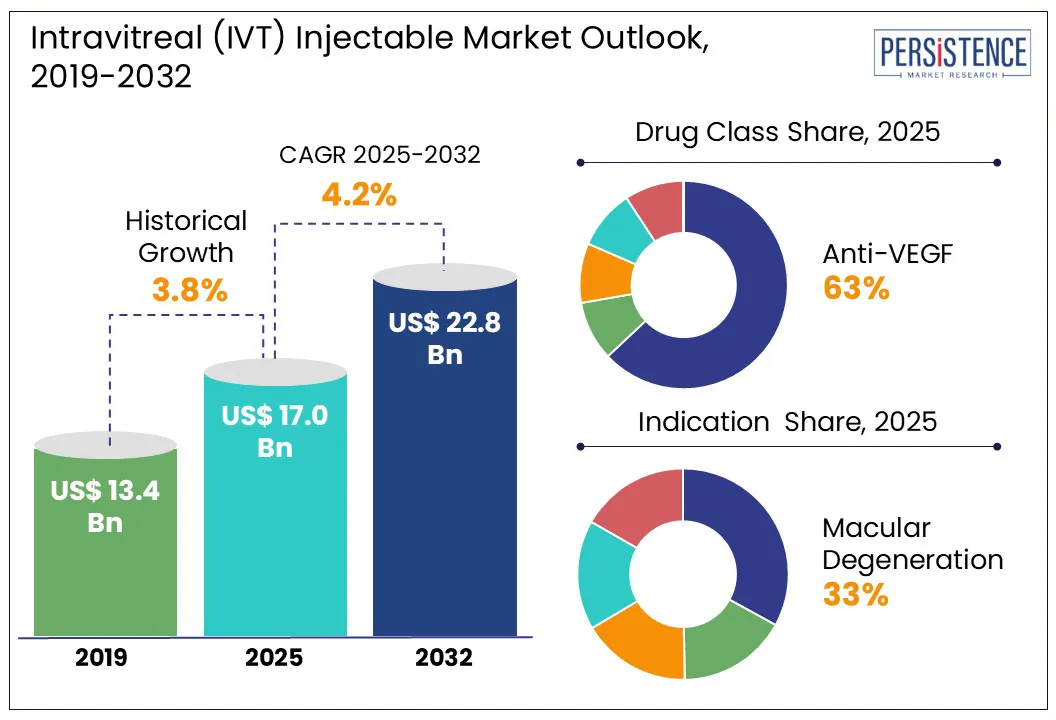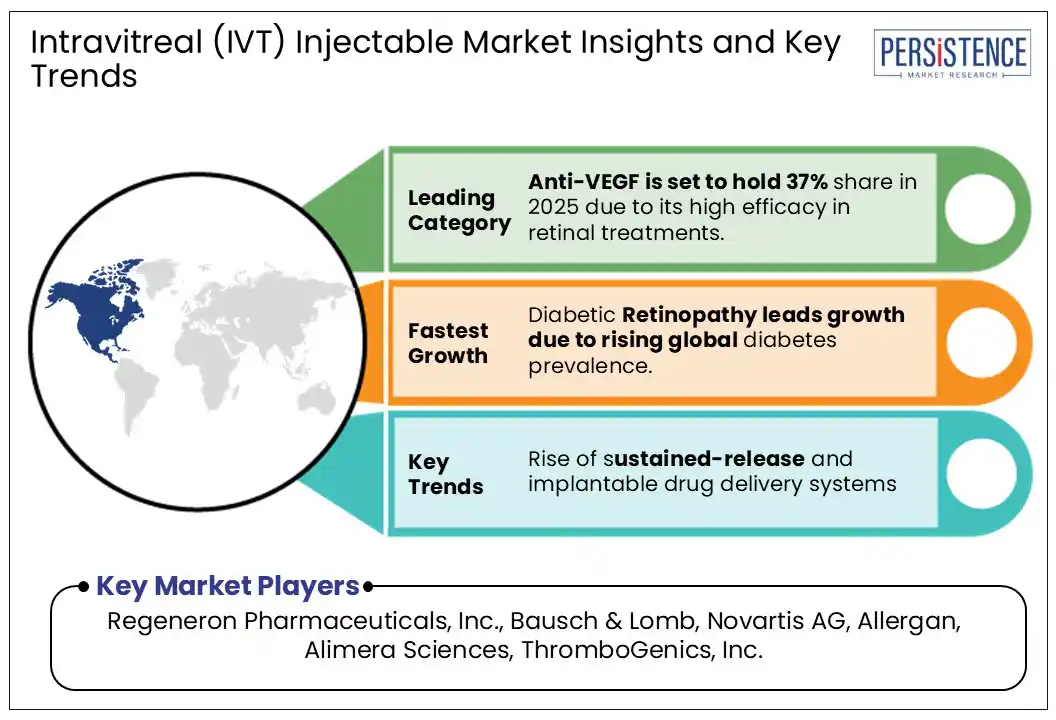ID: PMRREP25906| 160 Pages | 11 Jul 2025 | Format: PDF, Excel, PPT* | Healthcare

The global intravitreal (IVT) injectable market size is anticipated to reach a value of US$ 17.0 Bn in 2025 and is set to witness a CAGR of 4.2% from 2025 to 2032. The market will likely attain a value of US$ 22.8 Bn in 2032. The growing awareness of retinal disorders, personalized medicine, and innovative therapies are driving market growth. The market is also expanding in North America due to improved healthcare infrastructure and high incidence of retinal diseases.

Key Highlights of the Market
|
Market Attributes |
Key Insights |
|
Intravitreal (IVT) Injectable Market Size (2025E) |
US$ 17.0 Bn |
|
Projected Market Value (2032F) |
US$ 22.8 Bn |
|
Global Market Growth Rate (CAGR 2025 to 2032) |
4.2% |
|
Historical Market Growth Rate (CAGR 2019 to 2024) |
3.8% |
North America market is poised grow substantially due to its developed healthcare infrastructure and a high incidence of retinal diseases. The region's strong emphasis on research and development has fostered innovation, while the presence of leading pharmaceutical companies fuels competition and enhances treatment options.
A comprehensive reimbursement framework ensures accessibility to advanced therapies further propelling market growth. This combination of factors positions North America as a dominant player in the intravitreal injectable landscape driving advancements in patient care and treatment outcomes.
Europe market emerges as the second leading regional market. The region benefits from a robust healthcare system that prioritizes patient access to quality care and treatment. Growing awareness of retinal disorders has led to increased screening and diagnosis driving demand for intravitreal injections.
The aging population in Europe coupled with the introduction of innovative therapies enhances the market potential. As healthcare providers focus on improving patient outcomes, Europe continues to solidify its position as a significant contributor to the intravitreal injectable market's growth.
|
Category |
Market Share in 2025 |
|
Indication - Macular Degeneration |
33.1% |
Macular degeneration is the leading segment in the market by indication. This segment is projected to capture 33.1% of the market share in 2025. This segment's dominance is primarily driven by the high prevalence of age-related macular degeneration (AMD), which significantly affects the elderly population.
Intravitreal therapies, particularly anti-VEGF treatments have demonstrated remarkable effectiveness in managing AMD by slowing disease progression and preserving vision. As awareness of AMD increases and more patients seek treatment, the demand for intravitreal injections in this segment is expected to grow substantially.
In terms of drug class, anti-VEGF is the leading segment in the intravitreal (IVT) injectable market. These drugs play a crucial role in treating various retinal diseases including wet age-related macular degeneration (AMD) and diabetic retinopathy.
By inhibiting vascular endothelial growth factor, anti-VEGF therapies effectively reduce abnormal blood vessel growth and leakage in the retina, which are common complications of these conditions. The proven efficacy and widespread adoption of anti-VEGF treatments among healthcare providers contribute significantly to their prominence in the market, driving ongoing research and development in this area.
The intravitreal (IVT) injectable market overview shows that the industry is growing continuously and is expected to grow in upcoming years. Intravitreal (IVT) injectables are specialized pharmaceutical formulations administered directly into the vitreous cavity of the eye primarily used for treating various retinal diseases.
The primary uses of IVT injectable include the treatment of conditions such as age-related macular degeneration (AMD), diabetic retinopathy, retinal vein occlusion, and other sight-threatening diseases. These therapies have revolutionized the management of retinal disorders, enabling sustained drug release and improved patient outcomes.
The sector is experiencing significant growth driven by advancements in drug development, an increasing prevalence of retinal diseases, and the rise in geriatric populations. Current intravitreal injectable (IVT) market trends indicate a shift toward the use of long-acting therapies and combination treatments that aim to improve patient compliance and reduce the frequency of injections.
The emergence of innovative delivery systems such as implantable devices is gaining traction, offering sustained drug release and further enhancing treatment efficacy. The increasing adoption of personalized medicine approaches coupled with improved diagnostic tools is also shaping the landscape of the IVT injectable market.
The market is witnessing a surge in research and development efforts focusing on novel therapeutics and formulations, which are expected to broaden the treatment options available to eye care professionals.
The intravitreal (IVT) injectable market analysis has exhibited steady growth over the past few years, with a CAGR of 3.8% during the period from 2019 to 2024. This growth can be attributed to several factors including the increasing incidence of retinal diseases, advancements in injectable therapies, and growing awareness of eye health among the aging population.
The introduction of innovative anti-VEGF agents and corticosteroids has significantly improved treatment outcomes leading to high adoption rates among healthcare providers. The market is projected to accelerate further with an anticipated CAGR of 4.2% from 2025 to 2032. This upward trajectory is expected to be fueled by ongoing research and development efforts to create more effective and longer-lasting injectable therapies.
The rise of personalized medicine and the integration of advanced technologies, such as sustained-release delivery systems will likely to open several opportunities. As the healthcare landscape continues to evolve, the market is well-positioned for sustained growth driven by innovation and an increasing focus on improving patient outcomes in ophthalmic care.
The rising incidence of retinal diseases particularly age-related macular degeneration (AMD) and diabetic retinopathy is a significant growth driver for the intravitreal (IVT) injectable market demand.
As the global population ages, the number of individuals affected by these conditions continues to grow leading to a high demand for effective treatment options. Intravitreal injections, particularly those utilizing anti-VEGF therapies have proven to be effective in slowing disease progression and preserving vision. Consequently, driving their adoption among healthcare providers and patients alike.
Innovations in drug formulations and delivery systems are propelling the market growth. Recent developments include long-acting therapies and sustained-release formulations that enhance the efficacy and duration of treatment. These advancements not only improve patient compliance by reducing the frequency of injections but also minimize the risk of complications associated with repeated procedures.
As new therapies continue to emerge, they are expected to expand treatment options and further stimulate market growth.
Increased awareness of eye health and the importance of early diagnosis and treatment of retinal diseases is driving intravitreal (IVT) injectable market expansion. Educational initiatives by healthcare organizations and advancements in diagnostic technologies have made it easy for patients to seek timely treatment.
Improved access to healthcare services particularly in developing regions is facilitating the adoption of IVT injectables. As more patients become aware of available treatment options, the demand for intravitreal injections is likely to rise contributing to the market expansion.

One of the significant factors impeding the intravitreal (IVT) injectable market growth is the potential for complications and side effects associated with intravitreal injections. Patients may experience adverse reactions such as inflammation, retinal detachment, or endophthalmitis, which can deter both patients and healthcare providers from opting for this treatment.
The fear of these complications can lead to hesitancy in initiating therapy, particularly among patients with pre-existing conditions or those who have previously experienced adverse effects. This concern can limit the overall adoption of IVT injectables in clinical practice.
The cost of IVT injectable therapies can be a significant barrier to market particularly in regions with limited healthcare resources. Many of these treatments are expensive, and not all patients have adequate insurance coverage to afford them.
This financial burden can lead to disparities in access to care, particularly for low-income populations or those in developing countries. Additionally, the need for specialized healthcare facilities and trained personnel to administer these injections further complicates accessibility, potentially limiting the market's expansion and patient reach.
There is a significant opportunity for intravitreal (IVT) injectable market growth through the development of novel therapeutics targeting various retinal diseases. Ongoing research and clinical trials are exploring innovative drug formulations and biologics that could enhance treatment efficacy and safety profiles.
By focusing on personalized medicine approaches, companies can create tailored therapies that address the specific needs of patients potentially leading to better outcomes. As new breakthroughs and treatment options emerge, the market is likely to experience renewed interest and increased adoption among healthcare providers.
The integration of advanced delivery systems represents a promising opportunity for intravitreal (IVT) injectable market value. Innovations such as implantable devices and sustained-release formulations can improve drug delivery efficiency and reduce the frequency of injections, enhancing patient compliance.
These technologies can address some of the limitations associated with traditional intravitreal injections such as the need for regular visits and associated discomfort. By focusing on the development and commercialization of these advanced delivery systems, companies can cater to the growing demand for more effective and convenient treatment options in ophthalmology.
The intravitreal injectable market is characterized by intense competition among key players striving to innovate and expand their product portfolios. Notable companies include Regeneron Pharmaceuticals, which launched EYLEA (aflibercept) in a new formulation in 2022, enhancing its efficacy for retinal conditions.
These innovations reflect a trend toward developing long-acting therapies, positioning these companies to capture a larger share of the growing market by improving patient outcomes and compliance.
Recent Developments in the Intravitreal (IVT) Injectable Market
The Global market is estimated to increase from US$ 17.0 Bn in 2025 to US$ 22.8 Bn in 2032.
Rising retinal disorders, aging population, growing diabetic cases, advanced biologics, and improved injection techniques drive the IVT injectable market.
The market is projected to record a CAGR of 4.2% during the forecast period from 2025 to 2032.
Opportunities include biosimilar development, sustained-release formulations, untapped emerging markets, teleophthalmology integration, and expanding indications beyond retinal diseases.
Major players include Regeneron Pharmaceuticals, Inc., Bausch & Lomb, Novartis AG, Allergan, Alimera Sciences, ThromboGenics, Inc. and Others.
|
Attributes |
Details |
|
Forecast Period |
2025 to 2032 |
|
Historical Data Available for |
2019 to 2024 |
|
Market Analysis |
US$ Billion for Value |
|
Key Regions Covered |
|
|
Key Market Segments Covered |
|
|
Key Companies Profiled |
|
|
Report Coverage |
|
|
Customization & Pricing |
Available upon request |
By Drug Class
By Indication
By Region
Delivery Timelines
For more information on this report and its delivery timelines please get in touch with our sales team.
About Author